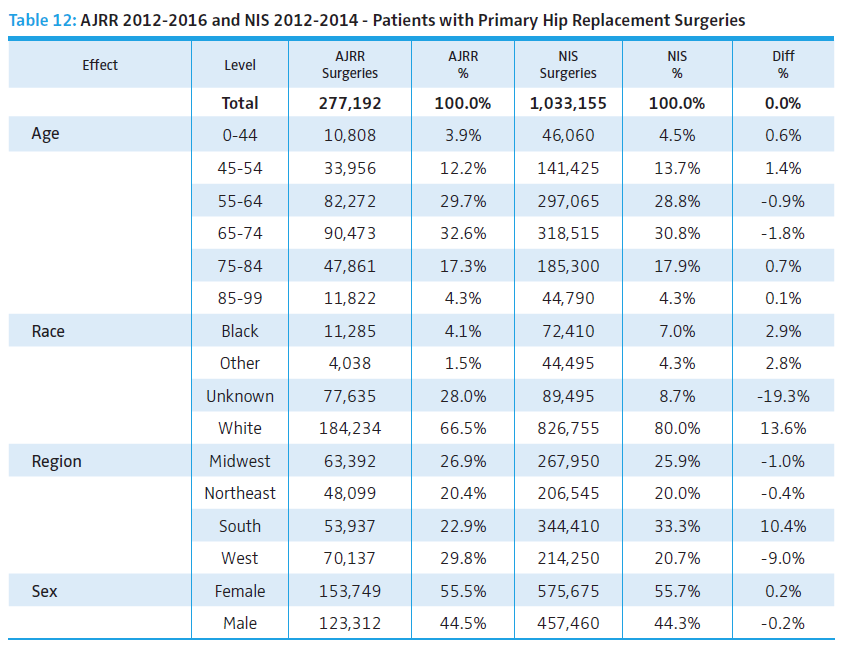
Measurement of volume metrics are important to the American Joint Replacement Registry (AJRR) because they provide indicators and insights into our data and in what areas we need to focus and improve. With over 1,000 contracted hospitals/surgery centers providing data on more than 8,000 surgeons, annually we collect more arthroplasty procedures than any other registry in the world. Over 1.3 million hip and knee arthroplasty procedures are currently housed in the AJRR database.
AJRR began the Registry because no national comparator for arthroplasty existed. Each year, AJRR makes significant and actionable progress toward becoming that premier resource. Furthermore, we take measures toward demonstrating that our data is both relevant and nationally representative through multiple statistical analysis efforts. Two of those efforts are highlighted below (one is ongoing):
National Inpatient Sample (NIS) Comparison
When compared with the NIS database, the AJRR arthroplasty population is quite representative of that seen in the U.S. overall.
AJRR undertook a comparison of its data from 2012 – 2016 to data reported to the National (Nationwide) Inpatient Sample (NIS) between 2012 – 2014. The NIS was developed for the Healthcare Cost and Utilization Project (HCUP), includes all payers, and is the largest publicly available inpatient health care database in the United States, with information on more than seven million hospital stays each year. Since 2012, the NIS approximates a 20% stratified sample of all discharges from U.S. community hospitals that perform joint replacement procedures. AJRR’s database represents approximately 28% of all total hip arthroplasty (THA) and total knee arthroplasty (TKA) procedures performed at institutions in the United States.
This comparison indicates that the demographic profiles of the patients undergoing TKA and THA in the AJRR and NIS databases are quite similar. Specifically, sex and age distribution are nearly identical. The geographic distribution of the hospitals performing joint replacement surgery is also similar for the Midwest and Northeast regions between the two databases. However, the differences noted for the South and West likely are the result of slower recruitment of southern hospitals to AJRR, while the rapid inclusion of numerous hospitals in the California Joint Replacement Registry (CJRR) bolstered the relative percentage seen in western states.


Analysis of ResDAC CMS Data
Analysis currently underway, results pending.
In June 2018 AJRR received, through the ResDAC process, claims data from the Centers for Medicare & Medicaid Services (CMS) which will be linked to the existing AJRR database. AJRR is the first Qualified Clinical Data Registry to access CMS claims data via the ResDAC process as provided for under Congressional legislation. AJRR applied for access to these data in the expectation that the claims would allow for assessments of data quality in the Registry, long-term patient results including reoperations that occur anywhere in the U.S., and greater insight into patient comorbidities for risk adjustment. Examining the CMS claims and proceeding with analysis has just begun, but our initial expectation is that much is to be gained in our understanding of the U.S. arthroscopy market and national representative nature of the Registry. David G. Lewallen, MD, AJRR Medical Director, said, “We hope to be able to take those 1 million patients, half of which are Medicare [patients], and do survivorship curves. If successful, this is going to take us (AJRR) to the next level (of U.S. market understanding).”
Periodic updates on the process and findings of this effort will be shared with AJRR subscribers as those results become available.
Risk-adjusted Data Furthers Understanding of National Arthroplasty Market
In 2018, AJRR provided updated data specifications with a finalized Post-op Complication Layout. AJRR now collects three levels of data and will report risk-adjusted longitudinal data and benchmarking accordingly. The goal of AJRR benchmarking is to incorporate Level II risk-adjusted data to enable Registry participants to accurately benchmark their outcomes and costs against the nation, a region, the participant's historical performance, and other desired reference groups.
AJRR's new risk-adjusted efforts will underpin quality improvement efforts across the country.
Attributions
Statistical analysis in the AJRR National Distribution analysis was completed by Exponent, Inc. The CMS Claims Data analysis is led by AAOS statistician Peter Shores.
For information about the AJRR RegistryInsights™ platform, speak with a Business Development Representative at (847) 292-0530 or Request A Demo today!
Be sure to leave a comment in the form below!

